If you’re looking for the most religiously diverse counties in America, head to New York. If you’re looking for the least religiously diverse counties in America, head to Mississippi and Alabama.
That’s the top-line takeaway from the most comprehensive documentation of religious diversity at the county level ever produced. The data come from Public Religion Research Institute’s omnibus 2020 Census of American Religion, which encompasses 453,822 interviews conducted from 2013 to 2019, including 53,474 bilingual telephone interviews in 2019.
PRRI data was merged with American Community Survey data on 3,142 counties across all 50 states to produce estimates of the religious demographics of every county in the U.S. Then researchers created an index that assigned a score of 1 for complete diversity, meaning every religious group is present with equal size, and a score of 0 for a complete lack of diversity with one religious group comprising the entire population of a given county.
By policy, PRRI does not release its complete datasets for at least one year, so it is not possible for the public to search for religious diversity scores. However, the research firm released several top-10 lists drawn from the data and asset of visual maps.
Most and least religiously diverse
Among the 10 most religiously diverse counties in America, diversity scores are exceptionally high, all ranking above 0.863, with 1.0 representing complete and equal diversity, a goal unlikely to be found in any county.
 The most religious diverse counties, in order, are Kings County, N.Y.; Queens County, N.Y.; Montgomery County, Md.; Navajo County, Ariz.; Santa Clara County, Calif.; Middlesex County, N.J.; Rockland County, N.Y.; New York County, N.Y.; Maui County, Hawaii; Howard County, Md.
The most religious diverse counties, in order, are Kings County, N.Y.; Queens County, N.Y.; Montgomery County, Md.; Navajo County, Ariz.; Santa Clara County, Calif.; Middlesex County, N.J.; Rockland County, N.Y.; New York County, N.Y.; Maui County, Hawaii; Howard County, Md.
The least religiously diverse counties all fall in the American South and are, in order: Noxubee County, Miss.; Panola County, Miss.; Conecuh County, Ala.; Amite County, Miss.; Marion County, Miss.; Perry County, Miss.; Ashley County, Ark.; Greene County, Miss.; Smith County, Miss.; and Clarke County, Miss.
PRRI found the average religious diversity score by county in the U.S. is 0.625 — which indicates significant diversity. Religious diversity was found to be greatest in urban areas.
The new research also slices county data by specific religious groups, offering a snapshot of both race and religious identification, as well as majority and minority religions.
White Christians
 For example, white Christians make up 44% of the U.S. population but are most heavily concentrated in counties in the Midwest, PRRI said. About one-third of white Christians live in urban areas, while 43% live in suburban areas and 24% in rural areas.
For example, white Christians make up 44% of the U.S. population but are most heavily concentrated in counties in the Midwest, PRRI said. About one-third of white Christians live in urban areas, while 43% live in suburban areas and 24% in rural areas.
The 10 highest concentrations of white Christians are found in these counties, all with more than 80% representation: Lyon County, Iowa; Meeker County, Minn.; Redwood County, Minn.; Mercer County, Ohio; Madison County, Idaho; Campbell County, Tenn.; Osage County, Mo.; Somerset County, Pa.; Wayne County, Tenn.; Wilkes County, N.C.
White evangelical Protestants
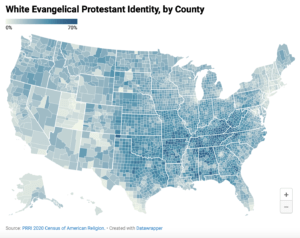 Looking more narrowly as white Christians who identify as evangelical Protestants shifts the focus away from the Midwest and to the South. Nearly one-third of white evangelical Protestants live in urban areas, 41% live in suburban areas, and 29% live in rural areas. This group accounts for 14% of the total U.S. population.
Looking more narrowly as white Christians who identify as evangelical Protestants shifts the focus away from the Midwest and to the South. Nearly one-third of white evangelical Protestants live in urban areas, 41% live in suburban areas, and 29% live in rural areas. This group accounts for 14% of the total U.S. population.
The highest concentrations of white evangelical Protestants are found in these counties: Marion County, Ala.; Campbell County, Tenn.; Johnson County, Tenn.; Fayette County, Ala.; McCreary County, Ky.; Scott County, Tenn.; Cullman County, Ala.; Cocke County, Tenn.; Prentiss County, Miss.; Wilkes County, N.C..
White mainline Protestants
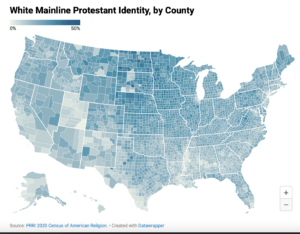 “Mainline” Protestant is a term historically used to describe the so-called “Seven Sisters,” which are the United Methodist Church, the Evangelical Lutheran Church in America, the Presbyterian Church (USA), the Episcopal Church in America, American Baptist Churches USA, the United Church of Christ, and the Disciples of Christ.
“Mainline” Protestant is a term historically used to describe the so-called “Seven Sisters,” which are the United Methodist Church, the Evangelical Lutheran Church in America, the Presbyterian Church (USA), the Episcopal Church in America, American Baptist Churches USA, the United Church of Christ, and the Disciples of Christ.
This group makes up 16% of the U.S. population and is most heavily concentrated in the Midwest. About one-third live in urban areas, 42% live in suburban areas, and 23% live in rural areas.
The highest concentrations of white mainline are found in these counties: Pope County, Minn.; Chippewa County, Minn.; Stutsman County, N.D.; Clayton County, Iowa; Dunn County, Wisconsin Wis.; O’Brien County, Iowa; Faribault County, Minn.; Otter Tail County, Minn.; Fillmore County, Minn.; Mille Lacs County, Minn.
White Catholics
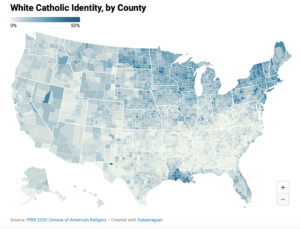 Representing 12% of the population, white Catholics are most heavily concentrated in the Northeast and Midwest and in southern Louisiana. They most frequently live in the suburbs (48%), followed by urban areas and rural areas (19%).
Representing 12% of the population, white Catholics are most heavily concentrated in the Northeast and Midwest and in southern Louisiana. They most frequently live in the suburbs (48%), followed by urban areas and rural areas (19%).
The 10 highest concentrations of white Catholics are found in these counties: Dubuque County, Iowa; Lackawanna County, Pa.; Vermilion Parish, La.; Calumet County, Wis.; Clinton County, N.Y.; St. Martin Parish, La.; Bristol County, Mass.; Lafourche Parish, La.; Stearns County, Minn.; Gloucester County, N.J.
Black Protestants
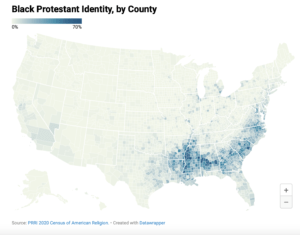 Black Protestants make up 7% of the U.S. population and are counted by PRRI distinctly from white Protestants, even though in reality Black and white worshipers may attend the same churches. The data gets sorted based on both religious identification and race to get more detailed insights.
Black Protestants make up 7% of the U.S. population and are counted by PRRI distinctly from white Protestants, even though in reality Black and white worshipers may attend the same churches. The data gets sorted based on both religious identification and race to get more detailed insights.
When the Protestant field is analyzed by race as a secondary factor, PRRI finds Black Protestants most heavily concentrated in the South and Southeast, particularly in the Deep South. About half (48%) live in urban areas, while 37% live in suburban areas and only 15% in rural areas.
The highest concentrations of Black Protestants are found in these counties, each with more than 50% representation: Holmes County, Miss.; Noxubee County, Miss.; Bullock County, Ala.; Macon County, Ala.; Coahoma County, Miss.; Leflore County, Miss.; Sumter County, Ala.; Washington County, Miss.; Sunflower County, Miss.; Williamsburg County, S.C.
Hispanic Protestants
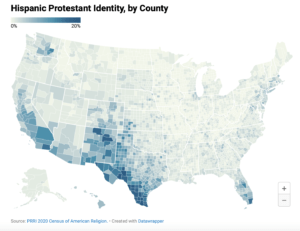 As with Black Protestants, PRRI applies a double filter on its data to identify Hispanic Protestants, regardless of what kind of Protestant church they attend. PRRI finds Hispanic Protestants make up 4% of the U.S. population and are concentrated in the Southwest and the West, particularly along the border between Texas and Mexico. They are evenly split between urban areas (45%) and suburban areas (43%), while just 12% live in rural areas.
As with Black Protestants, PRRI applies a double filter on its data to identify Hispanic Protestants, regardless of what kind of Protestant church they attend. PRRI finds Hispanic Protestants make up 4% of the U.S. population and are concentrated in the Southwest and the West, particularly along the border between Texas and Mexico. They are evenly split between urban areas (45%) and suburban areas (43%), while just 12% live in rural areas.
The highest concentrations of Hispanic Protestants are found in these counties, with none representing more than 21% of the population: Hidalgo County, Texas; Maverick County, Texas; Zavala County, Texas; Cameron County, Texas; Zapata County, Texas; Kleberg County, Texas; San Miguel County, N.M.; Duval County, Texas; Dimmit County, Texas; Webb County, Texas.
Hispanic Catholics
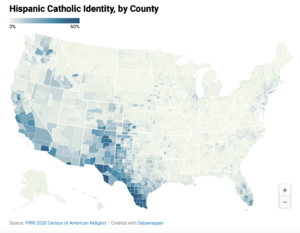 PRRI data identifies twice as many Hispanic Catholics (8% of the population) in America as Hispanic Protestants. As with Hispanic Protestants, Hispanic Catholics primarily live in the Southwest and the West, particularly along the border between Texas and Mexico but also in California. And they, too, are split closely between urban (46%) and suburban areas (43%), with only 10% living in rural areas.
PRRI data identifies twice as many Hispanic Catholics (8% of the population) in America as Hispanic Protestants. As with Hispanic Protestants, Hispanic Catholics primarily live in the Southwest and the West, particularly along the border between Texas and Mexico but also in California. And they, too, are split closely between urban (46%) and suburban areas (43%), with only 10% living in rural areas.
The highest concentrations of Hispanic Catholics are found in these counties, with much higher percentages (49% to 59%) than noted for Hispanic Protestants in their predominant counties: Zapata County, Texas; Starr County, Texas; Webb County, Texas; Maverick County, Texas; Santa Cruz County, Ariz.; Zavala County, Texas; Duval County, Texas; Cameron County, Texas; Imperial County, Calif. Hidalgo County, Texas.
Seven of the 10 counties with the highest concentration of Hispanic Catholics also have the highest concentration of Hispanic Protestants.
Others
PRRI also reports on a number of other classifications of Christians that each represents 2% or less of the total population. These include Mormons (1%), multiracial Christians (2%), AAPI Christians (1%), Native American Christians (1%), Black Catholics (1%), Christians who did not provide a race or ethnicity (1%), Jehovah’s Witnesses (0.5%), and Orthodox Christians (0.5%).
Jewish Americans make up 1% of the U.S. population and are most likely to be found in the Northeast and areas around New York City.
Muslim Americans make up 1% of the U.S. population and are primarily concentrated in major metropolitan areas, particularly in the New York City area.
Buddhist Americans make up 1% of the U.S. population and are primarily concentrated in Hawaii and the West Coast, particularly in the San Francisco Bay Area, with two New York counties among the top 10.
Hindu Americans make up less than 1% of the U.S. population and are heavily concentrated in larger metropolitan regions, particularly near New York City and San Francisco, although among the top 10 county list are Collin County, Texas; Loudoun County, Va.; and Fort Bend County, Texas.
Religiously unaffiliated
In one of the most noted elements of PRRI’s latest national data, the firm reported that the religiously unaffiliated — sometimes known as “the nones” — now account for 23% of the population, down 4 points from its peak in 2018. PRRI’s numbers differ from those most often cited by other researchers that are drawn from different data sets.
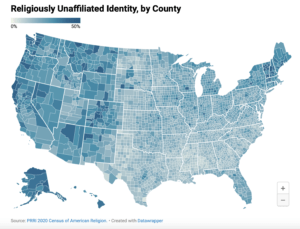 PRRI finds the religiously unaffiliated — which includes atheists, agnostics and those with no religious preference — are most likely to live in the suburbs (44%), followed by urban areas (39%), with only 17% living in rural areas.
PRRI finds the religiously unaffiliated — which includes atheists, agnostics and those with no religious preference — are most likely to live in the suburbs (44%), followed by urban areas (39%), with only 17% living in rural areas.
And while the religiously unaffiliated live all across the country, they are most likely to be found in the West and the Northeast.
The highest concentrations of religiously unaffiliated Americans are found in these counties, where between 44% and 49% of the population are unaffiliated: San Juan County, Wash.; Multnomah County, Ore.; Glacier County, Mont.; Humboldt County, Calif.; Tompkins County, N.Y.; Windham County, Vt. (45%); Pitkin County, Colo.; Benton County, Ore.; Jefferson County, Wash.; Bennington County, Vt.
Related articles:
New national survey flips the narrative on mainline Protestants and the ‘nones,’ but why?
In BNG webinar, Ryan Burge details the double threat to denominational churches in America


